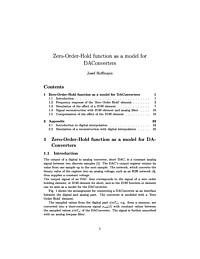
Zero-Order-Hold function as a model for DAConverters
The output of a digital to analog converter, short DAC, is a constant analog signal between two discrete samples. The DAC's output register retains its value from one sample up to the next sample. The network, which converts the binary value of the register into an analog voltage thus supplies a constant voltage and that leads to a stepped output signal. The analog smoothing filter connected at the output together with the frequency response of the DAC, modeled with a Zero-Order-Hold function, results in distortions. These are examined here and solutions to compensate for them are presented.


















